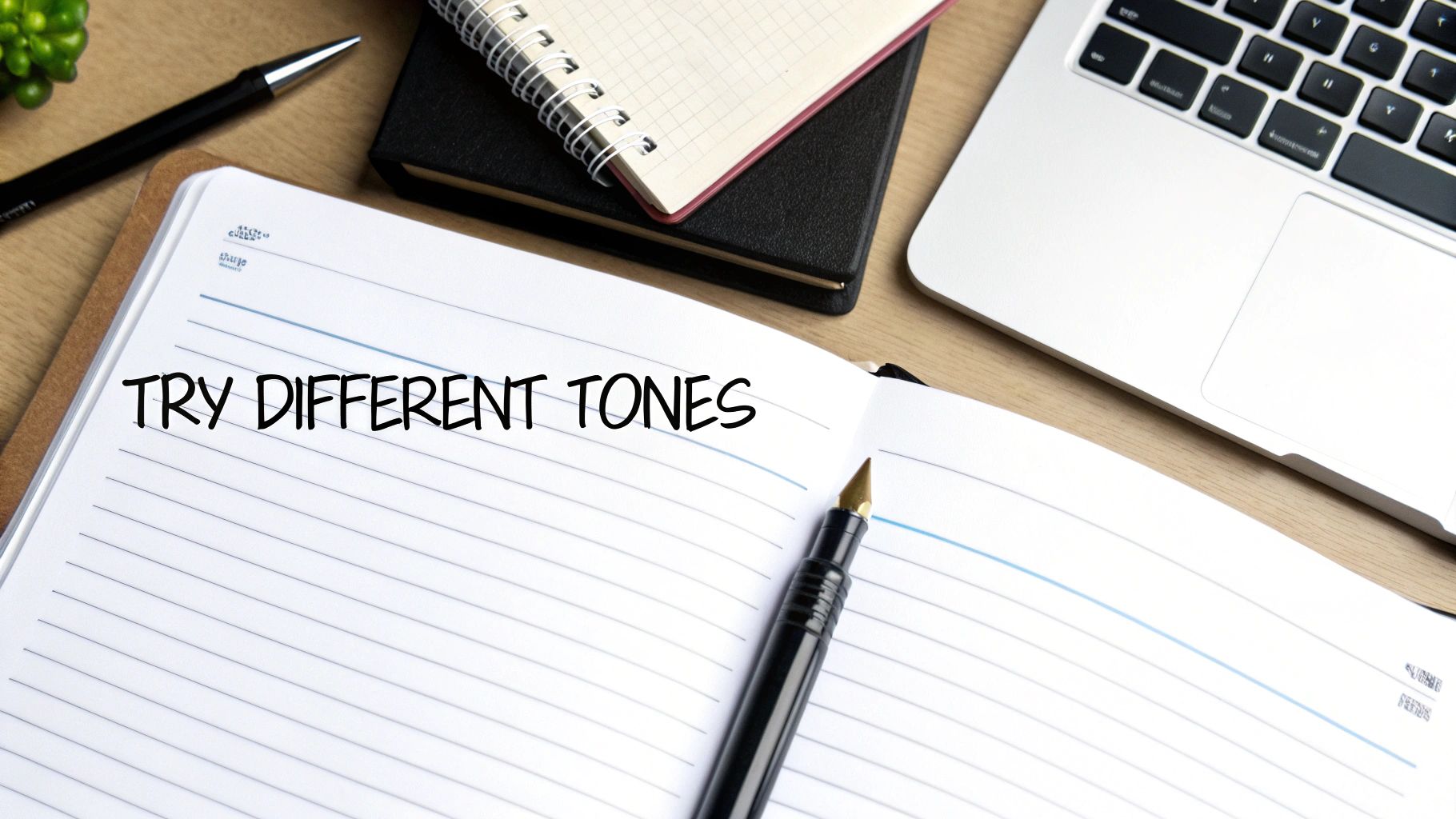
How to Find Your Writing Voice: Unlock an Authentic Style
Published on 2025-10-31
Finding your writing voice isn't some mystical quest. It's about tapping into the unique personality, perspective, and rhythm that makes your writing sound like you. It’s the magic ingredient that turns a forgettable article into something that sticks with a reader. The whole process is a mix of looking inward, putting in the reps, and learning to trust your own way of saying things.
What Is Your Writing Voice and Why It Matters

Think of your writing voice as your personal fingerprint on the page. It’s what makes your work instantly recognizable, separating you from every other writer out there. It’s not just about what you say, but how you say it. Your word choices, sentence flow, and overall perspective all blend together to create a style that is uniquely yours.
Having a strong, authentic voice is more important than ever. It’s how you build a real connection with your audience, which is the foundation of trust and loyalty. When people feel like they know the person behind the words, they’re far more likely to stick around, share your work, and come back for more.
Voice, Tone, and Style Explained
It's super common to get these three terms mixed up, but knowing the difference is crucial for getting your writing just right.
- Voice: This is your core writing personality. It's who you are as a writer and stays pretty consistent no matter what you're writing about.
- Tone: Think of this as your attitude in a specific piece. Your tone can shift from serious to funny to sympathetic, all depending on the topic and who you're talking to. Your voice, however, stays the same underneath.
- Style: These are the nuts and bolts—the mechanics of your writing. It’s your choice of grammar, sentence structure, and punctuation. Do you love short, punchy sentences? Or do you prefer more complex, flowing prose? That’s your style, and it's a huge part of your voice.
To really nail this down, it helps to see the components side-by-side. Your voice is a combination of these four key elements.
The Four Pillars of Your Writing Voice
| Component | What It Means | Example in Action |
|---|---|---|
| Personality | The distinct character that comes through your words—are you witty, authoritative, empathetic, or quirky? | A tech blogger might have a helpful, slightly nerdy personality, simplifying complex topics with relatable analogies. |
| Pacing & Rhythm | The flow and speed of your writing, created by sentence length, structure, and punctuation. | Using short, staccato sentences to build excitement or longer, descriptive ones to create a thoughtful mood. |
| Word Choice (Diction) | The specific words you use. Do you prefer simple, everyday language or more formal, technical terms? | A fitness coach might use energetic, motivational words like "crush," "power," and "unleash." |
| Perspective | Your unique point of view, informed by your experiences, beliefs, and values. | A travel writer sharing a story about a trip gone wrong, focusing on the humorous lessons learned rather than the inconvenience. |
Thinking about your writing through this lens can help you see where you're already strong and where you might want to experiment a bit more.
The Power of an Authentic Human Voice
In a world filled with more and more automated content, a genuine human voice is what really cuts through the noise. Readers are hungry for connection, something that AI-generated text often fails to deliver.
Interestingly, we see this demand for personalization even in technology. The global Voice Assistant Market was valued at $7.35 billion and is expected to keep growing, largely because people want more personalized, human-like interactions. This tells us that even when we're talking to machines, we want to feel a sense of individuality.
Your writing voice is the ultimate differentiator. It’s what makes someone choose to read your article over thousands of others covering the same topic. It’s not about being perfect; it’s about being real.
Developing your voice is a journey, not something you figure out overnight. If you're looking for inspiration on how others do it, check out our guide on compelling brand voice examples. In the end, a real, authentic voice is what makes your writing not just inform, but truly connect.
Find Your Raw Material by Simply Observing

Here’s a secret: your most authentic writing voice isn't something you need to invent out of whole cloth. It’s already in you, probably just buried under layers of self-doubt and the constant pressure to sound “like a writer.”
The real first step is to excavate that raw material. Think of yourself as a detective of your own mind, trying to capture your natural way of thinking before that loud inner editor gets a chance to scrub it clean. Honesty, not perfection, is the goal here.
Start With Low-Stakes Writing Sprints
One of the best ways I've found to sneak past my own internal critic is freewriting. This isn't about creating something beautiful or polished. It's about the simple, messy act of getting words onto the page.
Just set a timer for five or ten minutes and go. Pick a simple prompt and write whatever comes to mind without stopping. Don't worry about spelling, don't fix your grammar, and definitely don't overthink it. If you hit a wall, literally write "I have no idea what to write" until a new thought pops in.
Here are a few prompts to get you started:
- Describe the taste of your morning coffee like you're telling a friend about it.
- What’s one tiny thing that got on your nerves today?
- Try to explain a topic you're obsessed with to someone who's never heard of it.
These quick bursts are great for loosening up and revealing your natural rhythms and word choices. Of course, sometimes just getting started is the hardest part. If you're staring at a blank page, our guide on how to overcome writer's block has some great strategies that might help.
Journal About the Small Stuff
Your unique point of view comes alive in the specifics of your daily life. It’s easy to get lost trying to write about big, abstract concepts, but your voice shines when you focus on the little details.
Try keeping a simple journal. You don't need to write pages—just a few sentences each day about something you noticed. Maybe it was the funny way a coworker told a story, an odd interaction you saw at the grocery store, or just the feeling of the sun on your skin.
By documenting these small moments, you're not just keeping a diary; you're practicing the art of observation. You'll start to see what kinds of details you naturally tune into, which is the very essence of a distinct voice.
This simple habit trains you to see the world through your own unique filter and find the words to describe it.
Write Candid Letters You'll Never Send
This is a powerful little exercise. Try writing about the exact same event or topic, but in letters to different people in your life. The magic happens when you change the recipient, because your tone and language will shift automatically.
For example, write about a project you just finished in three separate letters:
- To your best friend: It’ll probably be casual, maybe a little sarcastic, full of inside jokes and raw honesty about what went wrong.
- To a mentor you respect: You’ll likely become more structured and thoughtful, focusing on what you learned from the experience.
- To your grandmother: Your explanation might get simpler, hitting the emotional highs and lows without getting bogged down in jargon.
See how your voice adapted? You were still you in every single letter, but you highlighted different facets of your personality. This proves that an authentic voice isn't a rigid, one-size-fits-all style. It's a flexible, genuine, and multi-faceted way of communicating.
Learn from the Writers You Admire

The best writers are almost always obsessed readers. But to find your own voice, you have to change how you read. It's time to shift from reading for pure enjoyment to reading like a detective on a case. Instead of just getting swept away by the narrative, you’re now hunting for clues—the little fingerprints the author leaves that create their magic.
This has nothing to do with copying someone else's style. Think of it more like deconstruction. By pulling apart the work of writers you love, you can see the nuts and bolts of how they build their voice, one choice at a time.
Read Like a Writer
The next time a piece of writing stops you in your tracks, don't just move on. Pause and ask yourself, why? Why did that paragraph hit so hard? Get granular. Investigate the mechanics behind the feeling it gave you. This is how you start building a mental toolkit for what makes writing work.
Next time you're reading, find a paragraph you truly love. Grab a notebook and try to figure out what makes it so good.
Look for specific things like:
- Sentence Structure: Are the sentences long and winding, or are they short and sharp? Notice how the author mixes them up to control the pace and create a certain mood.
- Word Choice (Diction): Is the language simple and direct, or is it more decorative and descriptive? Do you see any surprising word combinations that make you look twice?
- Point of View: What's the author's attitude? Is it cynical? Hopeful? Funny? The perspective they choose completely colors the story they’re telling.
When you start analyzing writing this way, you train your ear to hear the craft. It's a game-changer because it reveals the incredible range of what’s possible with words.
Build a Voice Swipe File
A "swipe file" sounds technical, but it’s just a fancy name for a collection of writing examples that you find inspiring. It’s your own personal library of greatness. Whenever you read a sentence or a paragraph that makes you think, "Damn, I wish I'd written that," save it.
Your swipe file is more than a scrapbook of good writing. It’s a mirror. It reflects your own creative tastes and what you’re naturally drawn to.
Over time, you'll start to see patterns. Maybe you save a lot of passages with witty, rapid-fire dialogue. Or perhaps you're drawn to writers who can explain a really complicated idea with beautiful simplicity. These patterns are breadcrumbs leading you straight to the heart of a voice that feels like you.
But don't just collect—annotate. For every piece you save, jot down a quick note about why you saved it. Was it the clever metaphor? The confident, no-nonsense tone? That one little step turns a folder of examples into an active learning tool you can always come back to when you feel stuck. It’s an invaluable map for any writer trying to find their way.
Experiment with Tone to Find Your Range

Think of your writing voice like your actual speaking voice. You don't talk to your boss the same way you talk to your best friend or your grandma, but it's always recognizably you. An authentic voice isn't rigid or one-dimensional; it’s flexible.
To really get a feel for your own writing style, you need to stretch its legs and see what it can do. This means intentionally trying on different tones to see what fits, what feels awkward, and what just clicks. It’s less about a scientific process and more about creative play.
Try On Different Tonal Hats
Here’s a simple but surprisingly effective exercise: pick a totally mundane topic and write about it in wildly different ways. This takes the pressure off of coming up with a brilliant idea and lets you focus completely on how you say it.
Let's take your morning coffee, for instance. Try describing that simple ritual in three distinct tones:
- Joyful and Enthusiastic: All about the rich aroma, the comforting warmth, and the jolt of energy that promises a great day. Think positive, energetic language.
- Cynical and World-Weary: Frame it as the bitter fuel required to survive another pointless meeting. Get a little sarcastic, a little dramatic.
- Overly Dramatic and Poetic: Treat it like a sacred ceremony. Use flowing, descriptive prose to turn brewing a cup of joe into a profound, life-altering event.
Playing around like this shows you your natural tendencies. Maybe you find humor flows easily, but a serious tone feels like pulling teeth. That’s valuable information! This isn't about finding the one "correct" tone, but about understanding all the tools in your writer’s toolkit. To explore this further, check out our guide on the different tones of writing and how they connect with readers.
Adjust Your Voice for the Room
Your core voice should stay consistent, but you have to know how to adjust it for the context. A professional LinkedIn post needs a different vibe than a casual blog entry or a punchy tweet.
Imagine you're announcing a new project on two different platforms:
- On LinkedIn: You'd likely be more buttoned-up and results-oriented. The focus would be on professional wins and teamwork.
- On a personal blog: Here, you can let your hair down. A conversational, reflective tone that shares the behind-the-scenes story—challenges and all—would work perfectly.
This kind of adaptability is the mark of a confident writer. When you know the full range of your voice, you can dial different aspects up or down to connect with any audience without sounding like you're putting on an act.
This becomes especially critical when building a brand, whether for yourself or a business. As you experiment, it's worth thinking about the broader impact of tone on brand communication. How people perceive your message often comes down to these subtle tonal choices.
A quick note on the tools we use: the digital world is heavily skewed toward English, which makes up over 48% of the text-to-speech market. This means many writing assistants are subtly nudging you toward a certain cadence. To develop a voice that is truly your own, you have to be willing to question those automated suggestions and trust your gut.
Sharpen Your Voice Through Editing and Feedback
Your true writing voice often makes its first appearance in that messy, unfiltered first draft. But it’s the editing process where it gets polished and really starts to shine. This isn't just about hunting for typos; it's about editing with your ear. You need to listen for the rhythm and personality hiding in your words.
The most powerful trick I know is surprisingly simple: read your work out loud. Your ears will catch what your eyes skim over every single time. You'll stumble on clunky phrases, notice where the flow breaks, and immediately spot the moments where you sound like you’re trying too hard.
If it doesn’t sound like something you’d actually say, that’s a red flag that your voice is getting lost in translation.
Edit with Your Voice in Mind
To go beyond simple proofreading, you have to start asking better questions. As you read your draft aloud, use this checklist to really tune into the sound and feel of your writing.
- Does this actually sound like me? Seriously, be honest. Are you using certain words because you think they sound more "professional" or "writerly"? Ditch them.
- Is this the simplest way to say this? A clear voice is usually a direct one. Hunt down and destroy any fluff words that are cluttering up your message.
- Where does the energy drop? Pay attention to the sentences or paragraphs that make you feel bored. That's almost always where your authentic voice has checked out.
- Can the reader feel me in this? Does your sense of humor, your passion, or your perspective come through? The goal is for someone to feel like they know who’s behind the words.
As you get more comfortable with your style, trying out different tools can make a big difference. For instance, if you find it easier to speak your thoughts than to type them, you might want to explore dictation software tailored for writers. It’s a great way to capture your natural speaking patterns before you even start editing.
How to Get Feedback That Actually Helps
Getting a second set of eyes on your work is crucial, but vague feedback like "I liked it" is completely useless. You have to be strategic and guide people to give you the insights you need.
The point of feedback isn't to make your voice sound like someone else. It's to find out if the voice you think you're projecting is the one your reader is actually hearing.
When you ask someone to read your work, give them specific things to look for. Try asking questions like these:
- "Which parts sounded the most like me just talking to you?"
- "Was there any spot where you got bored or confused?"
- "If you had to describe the personality in this writing with three words, what would they be?"
This is the kind of feedback that’s pure gold. It gives you a clear picture of how your writing lands and helps you close the gap between your intent and your reader's reality.
This whole process is getting more interesting as digital tools play a bigger role in writing. The global voice and speech recognition market is expected to reach an incredible $53.67 billion by 2030, which means AI suggestions are becoming a normal part of the process. You can dig into more stats about this on Grand View Research.
Finding your voice today means learning when to accept a helpful suggestion and when to protect your own wonderfully human, slightly imperfect phrasing. By being intentional with your editing and asking for smart feedback, you make sure the voice that shines through is one-hundred-percent yours.
Answering Your Questions About Writing Voice
Finding your voice can feel a bit like chasing a ghost. It’s one of those things that’s easier said than done, and it’s totally normal to have questions as you try to put the theory into practice. Let’s tackle some of the most common hurdles writers run into.
Think of these as practical answers to get you through the moments of doubt and back to developing a style that is unapologetically you.
How Can I Change My Voice for Different Clients or Audiences?
This is a big one, especially if you're writing for other people. The trick is to see your voice as something flexible, not something set in stone. Your core personality—whether that’s your dry humor or your thoughtful perspective—doesn't just disappear. What changes is the tone.
It's just like how you talk in real life. You're the same person when you're texting your best friend as you are when you're emailing a potential boss. You just adjust your language to fit the context.
Here's how to do it without feeling like a fraud:
- Pinpoint your core traits: Are you naturally direct? Witty? Nurturing? Know what makes you, you.
- Study the audience: What are they looking for? Do they need a formal, authoritative guide or a friendly, relatable peer?
- Adjust the volume: For a B2B tech client, you might turn up the volume on your clarity and directness while turning down the casual humor. The voice is still yours—it's just dressed for a different party.
This isn’t about being inauthentic; it’s about being versatile. It’s how you connect with different kinds of people without losing the very thing that makes your writing interesting.
How Do I Know if My Writing Voice Is Any Good?
It's so easy to get stuck in your head, wondering if your voice is "good enough." But "good" is totally subjective. A much better question to ask is: Is my voice effective?
An effective voice is one that does its job. Does it connect with the people you’re trying to reach? Does it make them feel understood? Is it clear? If you can answer yes to those questions, then your voice is working just fine.
Don't chase a "perfect" voice. Aim for an honest one. Readers connect with realness way more than they connect with flawless, robotic prose. When your writing sounds like an actual human being, people pay attention.
Instead of judging your voice, just focus on refining it. The more you write, get feedback, and edit your own work, the stronger and more confident it will naturally become. Consistency will always beat perfection.
What if I Feel Stuck or Like I Have No Voice at All?
This is such a common feeling, but it’s almost always a sign of overthinking. Your voice isn't some treasure you have to discover on a map. It's something you uncover by simply doing the work.
When you're feeling completely stuck, go back to square one. Forget about "writing" and just try to communicate.
Seriously, record yourself talking about a topic you're passionate about, then transcribe what you said. That's your voice in its rawest, most natural state. Or, try writing a quick email to a good friend explaining a complicated subject. Pay attention to the words you use and the rhythm of your sentences when you aren't trying to sound like a "writer." Those are the ingredients. Your voice is already in there—you just have to let it come out and play.
Ready to stop staring at a blank page and start creating content that actually sounds like you? autoghostwriter uses powerful AI to help you generate authentic, engaging LinkedIn posts that capture your unique voice and personality.